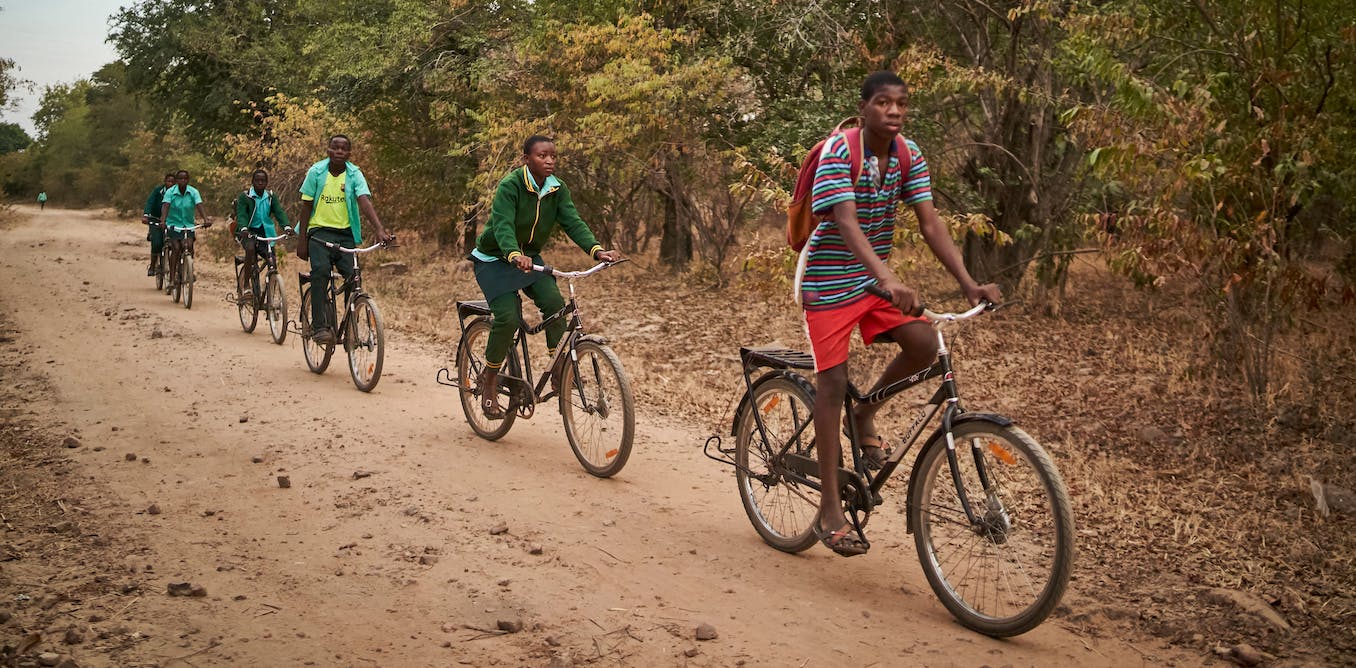The dumping of billions of tonnes of carbon dioxide and other greenhouse gases into the atmosphere yearly is already having a devastating impact around the world. This includes widespread flooding and droughts, raging wildfires, heatwaves and record temperatures.
Africa is particularly hard hit, with temperatures and sea levels rising faster across the continent than the global average.
In Zimbabwe, unreliable rainfalls and extended droughts are affecting hydro electricity generation, resulting in rolling blackouts. Food production is also affected. A large fraction of Zimbabwe’s population is at risk of severe hunger.
In 2015, almost all countries signed the Paris Agreement, a commitment to tackle climate change. The intention was to limit global temperature increase to below 2°C, or ideally 1.5°C. To achieve this, countries submitted individual plans, called Nationally Determined Contributions, to reduce their contribution to climate change. They agreed to update them every five years.
The continent of Africa contributes 2%-3% of the global greenhouse gas emissions causing climate change. Zimbabwe contributes less than 0.1%. Despite this small contribution, all African countries submitted their plans to reduce emissions.
In 2015, Zimbabwe committed to reducing its emissions by 33% by 2030. In 2021, it updated the target to a 40% reduction by 2030 across all sectors. This significant improvement increases the fraction of emissions that Zimbabwe will reduce from all emitting sectors.
The energy sector is responsible for about 34% of Zimbabwe’s total emissions. Including other sectors, like agriculture and forestry (58% of total emissions), waste (5%) and industrial processes (3%) will substantially reduce greenhouse gas emissions if Zimbabwe achieves its target.
How Zimbabwe can meet its emission reduction target
The updated target was informed by an assessment of how greenhouse gas emission could be reduced. The assessment was done by a team of researchers from Zimbabwe and the Stockholm Environment Institute at the University of York (including myself). It provided a clear plan to achieve the targets through the implementation of 28 specific policies and measures.
We assessed the benefits of these actions to mitigate climate change. We also reviewed other implications of taking each action locally in Zimbabwe.
Our research showed that by implementing its climate change plan, Zimbabwe would not only meet its international obligations, but achieve a broad set of health, social and development benefits.
The study assessed and quantified how the 28 actions to achieve Zimbabwe’s climate change plan would contribute to specific Sustainable Development Goals.
The top three benefits identified were improved public health, enhanced biodiversity, and greater access to reliable energy supplies. Each of these benefits is a priority within Zimbabwe’s National Development Strategy 1 2021-2025.
Good health is a constitutional right in Zimbabwe. Air pollution and unsafe sanitation are among the top 10 risk factors for health in Zimbabwe, and can be reduced by carrying out Zimbabwe’s climate change plan.
Reducing biodiversity losses will not only address an environmental challenge in Zimbabwe’s National Development Strategy, but preserve and enhance the tourism industry.
After years of unreliable energy supplies due to drought, and reliance on biomass fuels for cooking for much of the population, providing regular and reliable energy supplies is critical for alleviating poverty and economic growth.
Counting the benefits
Public health: Currently, almost 6,000 infants and over 8,000 adults die yearly from air pollution in Zimbabwe. Almost 1,600 people die from road traffic accidents, and 337 people die from unsafe sanitation. The study estimates that actions reducing greenhouse gases would also reduce air pollutant emissions by between 35% and 45% by 2030. This would lead to lower air pollution exposure, especially indoors where women and girls are most exposed while cooking.
Cleaner energy for cooking, improved transport systems and improved waste management all reduce air pollution. Increasing the use of public transport, or walking and cycling, rather than using cars can reduce road accidents and greenhouse gas emissions from transport.
Expanding access to sanitation systems would reduce the number of people dying from diarrhoeal diseases, and reduce methane emissions if the correct systems were installed.
Improved biodiversity: Zimbabwe’s climate change actions also include changes to how land is used. It aims to reduce burned areas of forest by 500,000 hectares and add 100,000 hectares of natural forest every year to 2025. The plan would also manage 250,000 more hectares of cropland using sustainable “conservation agriculture” techniques.
These actions were estimated to achieve multiple benefits, including improving soil health and protecting biodiversity, with possible reduction in the losses of both animals and plants.
Access to reliable energy: Achieving Zimbabwe’s climate change plan is built on extending electricity access to 95% of urban households and 75% of rural households. Actions in the plan include the expansion of renewable electricity generation, energy efficiency improvements, and reducing losses from electricity transmission and distribution. These steps can help ensure that access to energy is quick and effective, thereby reducing blackouts and reliance on fossil fuels.
In addition, the study shows that Zimbabwe could increase recycling rates while reducing emissions from waste. The country can equally reduce the time people – predominantly women and girls – spend cooking by switching to cleaner cooking fuels.
More than a sacrifice
Tackling climate change is often viewed as a necessary sacrifice, rather than an opportunity to improve lives.
Climate change targets are often focused solely on how they contribute to global, long-term aspirations, rather than the benefits that countries can achieve in the short term.
Our study shows the social, health and development benefits that Zimbabwe could enjoy by tackling its (small) contribution to climate change. This is not unique to Zimbabwe, nor a full list of all possible benefits from climate change action.
What is notable about the Zimbabwe study is that these local benefits were evaluated and quantified, alongside greenhouse gas emission reductions. They provide a positive case of what countries can gain from taking climate action.
Integrating quantitative assessment of local benefits when countries develop their climate change plans, following Zimbabwe’s example, could help boost national climate plans. This would in turn help the world meet necessary emission reduction timelines and avoid the worst impacts.




